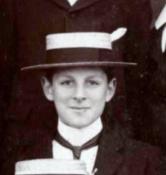
War Memorial
| Captain George Frederic WRAY | |
|
B Company, 1/4th Battalion Bedfordshire Regiment attached to the King's African Rifles Date of birth: 10th December 1881 Date of death: 16th January 1955 Died aged 73 Unknown |

|
| George Frederic Wray was born at Neswick Hall, Bainton in Yorkshire on the 10th of December 1881 the eldest son of Herbert George Wray, a gentleman, and Amy (nee Medcalf) Wray of Esplanade Terrace, Scarborough. He was educated at Hazelwood School until December 1895 where he was a member of the Football XI in 1895. The school magazine wrote the following on his football season that year: - "Half back, a fairly useful and safe kick and good hard worker." When he left the school magazine wrote: - "Will be welcomed at Wellington for his football and his amiable disposition." He went on to Wellington College where he was in Mr. Beresford’s House from January 1896 to 1899. He was commissioned as a 2nd Lieutenant in the 4th Battalion Bedfordshire Regiment (Militia) on the 28th of August 1900 and was promoted to Lieutenant on the 6th of December 1901. He saw service in the South African War in 1901 and resigned his commission on the 27th of February 1904. He then moved to Canada, and later to New Zealand where he became a farmer at Rangiwahia. Following the outbreak of war he returned to the UK and applied for a commission in the Special Reserve of Officers for the Bedfordshire Regiment on the 21st of December 1915. He was re-appointed as a 2nd Lieutenant in the Bedfordshire Regiment on the 22nd of February 1916 with seniority from the 11th of May 1914. He went on a bombing course at Marden Park, South Godstone in June 1916 and embarked for France with his battalion on the 25th of July 1916. Following the battalion’s losses at Beaucourt on the 13th of November 1916 during the Battle of the Somme, he was promoted to temporary Captain on the 17th of November and was given command of B Company. On the 15th of April 1917 he was undertaking a reconnaissance mission at Gavrelle in conjunction with the 10th Battalion Royal Dublin Fusiliers when he was wounded in the right thigh and the left leg by shrapnel. He was evacuated to the rear and was loaded on board the Hospital Ship Newhaven at Calais on the 21st of April and landed in Dover later the same day. As a result of his wounds he relinquished the rank of Temporary Captain with effect from the 15th of April 1917. On his recovery he sailed for East Africa on the 27th of May 1918 where he was attached to the King’s African Rifles at their headquarters at Nairobi returning to England on the 29th of April 1919. He was demobilised at No. 1 Dispersal Unit, Ripon on the 2nd of August 1919. He resigned his commission on the 1st of April 1920 after which he went to Ceylon as a rubber planter. He later returned to England and lived at Jordan House, 42 Preston Road, Weymouth in Dorset. He was cremated on the 19th of January 1955 and his ashes were interred in the grave of his uncle, the Reverend C.F. Medcalf, former Vicar of Preston and Sutton Poynz. |
|
| Went on to Wellington College |
Back